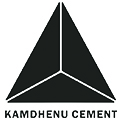Ever looked at a brick wall and noticed how the bricks are arranged in such a neat, interlocking pattern? That’s not just for looks! That clever arrangement is called a brick bond, and it’s the secret sauce behind every strong, stable, and beautiful wall. If you’re planning to build your dream home or any structure, understanding the different types of brick bonds is your first step. And to make that bond strong, you require the right partner: Kamdhenu Cement.
What Exactly is a Brick Bond in Construction?
In simple terms, a brick bond is the pattern in which bricks are arranged. It’s like the blueprint for the mason. The primary goal isn’t just aesthetics; it’s to distribute the weight and load evenly throughout the structure so we do not have weak, unbroken joints. A good brick bond ties the individual bricks together into a single, solid unit, ensuring your wall can stand strong against time and pressure. Getting this right is a cornerstone of masonry across all types of brick bonds in India.
10 Common Types of Brick Bond in India
There are several ways to arrange bricks, each with its own unique look and structural benefit. Let’s break down the most popular types of brick bonds used in construction today.
1. Stretcher Bond
What it is: when you lay the long, flat sides of the bricks.
This is the simplest pattern. All the bricks are laid like soldiers in a row, with each brick centered over the gap between the two bricks below it. It’s mostly used for thin walls, like the walls inside your house or garden walls.
2. Header Bond
What it is: when you see the short ends of the bricks.
Here, all the short ends (headers) are facing out. This makes a really thick wall, which is great for building super-strong foundations or curved walls, like for a round chimney.
3. English Bond
What it is: when you alternate between a full row of long sides and a full row of short ends.
This is a classic, super-strong pattern. One row is all stretchers (long sides), and the very next row is all headers (short ends). The headers line up perfectly in the middle of the stretchers below. It’s like a double-layered pattern that’s incredibly tough.
4. Flemish Bond
What it is: In a single row, a short end and a long side alternate.
This pattern is famous for its beautiful, decorative look. In every single row, a stretcher brick is placed right next to a header brick. There are two main types of Flemish bond: Double Flemish (the pattern shows on both sides of the wall) and Single Flemish (the pattern is only on one side).
5. Stack Bond
What it is: Bricks on top of another, such as a grid.
The bricks are laid end to end both horizontally and vertically, making straight lines up and down. Although it appears extremely modern and tidy, it’s not the most supportive pattern on its own and usually requires additional support.
6. English Garden Wall Bond
What it is: A simpler version of the English bond.
This pattern uses three rows of stretchers for every one row of headers. It’s strong but uses fewer of the short header bricks, which can make it a bit cheaper. It’s a popular choice for—you guessed it—garden walls!
7. Flemish Garden Wall Bond
What it is: A simpler version of the Flemish bond.
Similar to the one above, this pattern changes the fancy Flemish bond to have three stretchers followed by one header in each row. It gives a similar decorative look but is a bit easier and cheaper to build.
8. Dutch Bond
What it is: A mix that fixes a weakness.
This bond is a twist on the English bond. Every alternate stretcher course (row) has a header brick placed right in the middle of each stretcher brick. This helps strengthen the wall and fix any weak spots.
9. Rat-Trap Bond
What it is: Bricks laid on their side, creating a hollow wall.
This is a cool, energy-efficient pattern. A twist on the English bond. In every other row of stretchers, a header brick is placed right in the middle of a stretcher brick to add strength.
Best for: Reinforcing walls and fixing potential weak points. This acts like insulation, keeping the inside of a building cooler in summer and warmer in winter. It also uses fewer bricks!
10. Zig-Zag Bond
What it is: A cool, diagonal pattern across a wall.
This pattern is used for brick floors or garden paths. The bricks are laid at a 45 or 90-degree angle to the direction of the wall, creating a fun, zig-zagging or herringbone pattern. It’s great for adding visual flair
Why Does the Right Brick Bond Matter? The Advantages
Choosing the correct bond is crucial. Here’s why:
- Superior Strength: The right bond distributes load efficiently, preventing cracks and ensuring longevity.
- Enhanced Stability: It ties the masonry together, making the structure resistant to lateral forces and vibrations.
- Aesthetic Appeal: Bonds like Flemish add a layer of sophistication and character to a building’s facade.
- Economic Efficiency: Some bonds, like Stretcher, use fewer bricks and require less labour, reducing costs for appropriate applications.
Why Kamdhenu Cement is the Perfect Choice for Your Bonds?
No matter which of the wonderful types of brick bonds you choose, its strength ultimately depends on the mortar that holds it together. The mortar is the glue, and that glue is made from cement. This is where Kamdhenu Cement comes in.
For any of the types of brick bonds in India to perform at their best, they need reliable, high-quality cement. Kamdhenu Cement provides:
- Exceptional Bonding Strength: Our cement ensures a perfect, strong grip between bricks, making the entire structure monolithic and robust.
- Superior Workability: The smooth mix is easy for masons to work with, allowing them to lay bricks precisely and maintain clean, even joints, which is vital for complex patterns like the types of Flemish bond.
- Durability: Kamdhenu Cement offers excellent resistance to weathering, ensuring your beautiful brickwork and strong bonds last for generations.
- Trusted Brand: As a name synonymous with quality in the Indian construction industry, choosing Kamdhenu Cement is a step towards guaranteed peace of mind.
Conclusion
The technique of selecting from the different types of brick bonds is a mix of engineering and beauty. It’s about constructing walls as strong as they are beautiful. From the straightforward Stretcher to the types of Flemish bond, each has an important role to play.
But don’t forget, the design is just half the story. The true hero is the cement that holds it all together. To have a home standing tall and proud, select the correct types of brick bonds and combine them with Kamdhenu Cement to get good strength. Let’s build a foundation of trust and quality, together. Connect with Kamdhenu Cement Today!
Read Also : 10 Types and Properties of Bricks In Construction


